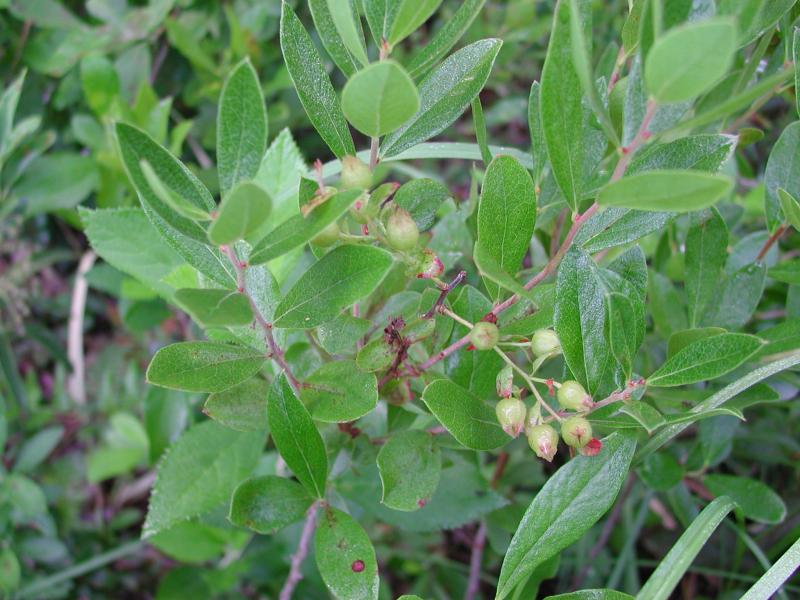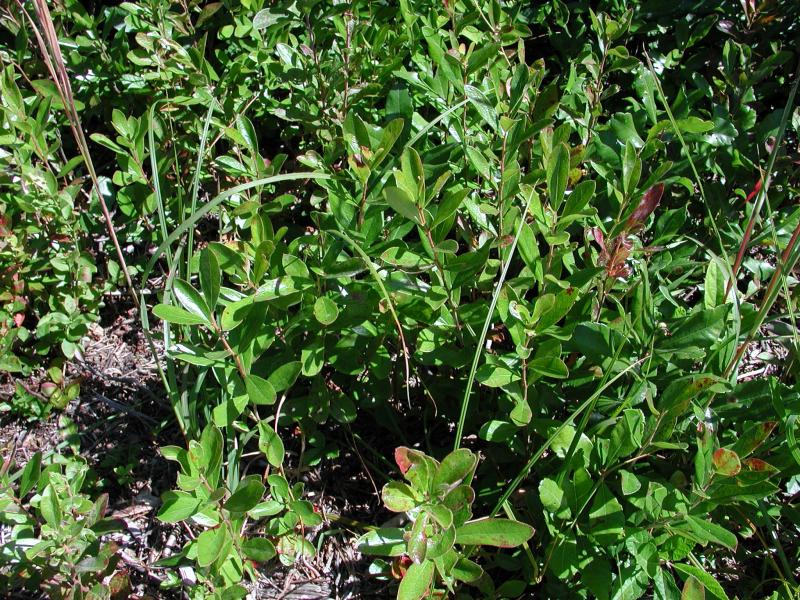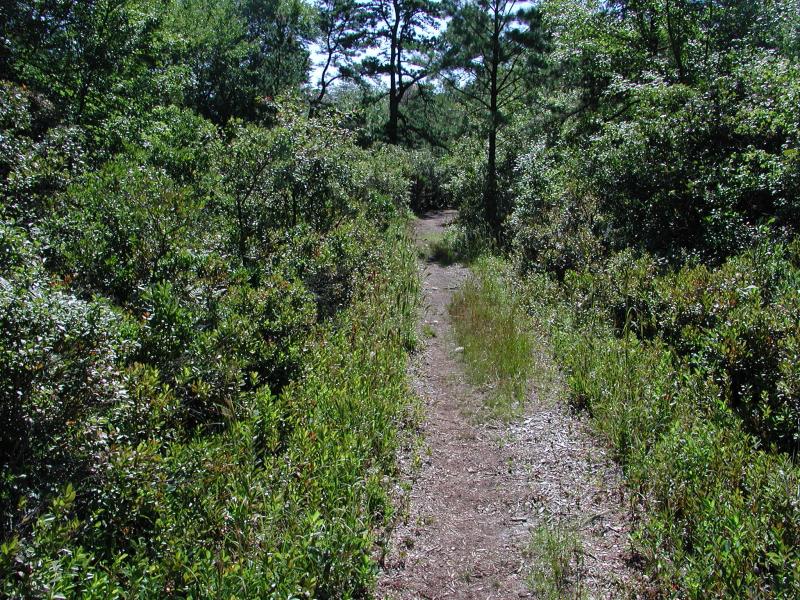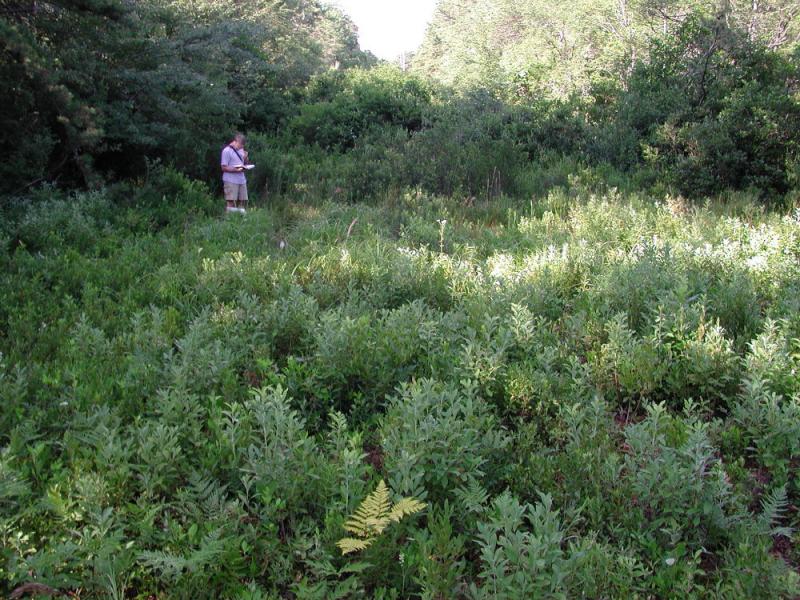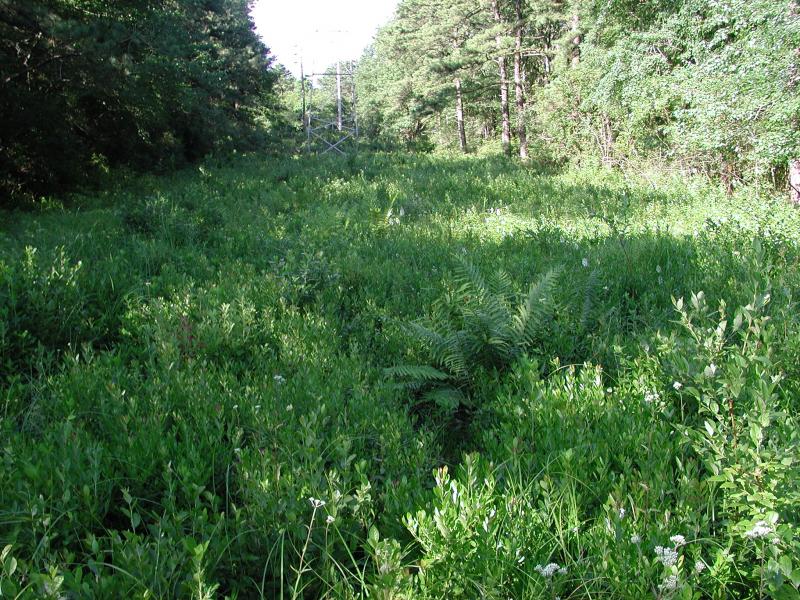Bog Huckleberry
Gaylussacia bigeloviana (Fern.) Sorrie & Weakley
- Class
- Dicotyledoneae (Dicots)
- Family
- Ericaceae (Heath Family)
- State Protection
- Endangered
Listed as Endangered by New York State: in imminent danger of extirpation in New York. For animals, taking, importation, transportation, or possession is prohibited, except under license or permit. For plants, removal or damage without the consent of the landowner is prohibited.
- Federal Protection
- Not Listed
- State Conservation Status Rank
- S1S2
Critically Imperiled or Imperiled in New York - Especially or very vulnerable to disappearing from New York due to rarity or other factors; typically 20 or fewer populations or locations in New York, very few individuals, very restricted range, few remaining acres (or miles of stream), and/or steep declines. More information is needed to assign either S1 or S2.
- Global Conservation Status Rank
- G4G5
Apparently or Demonstrably Secure globally - Uncommon to common in the world, but not rare; usually widespread, but may be rare in some parts of its range; possibly some cause for long-term concern due to declines or other factors. More information is needed to assign either G4 or G5.
Summary
Did you know?
The genus Gaylussacia is named after the famous French chemist and physicist Joseph Louis Gay-Lussac. The species name means a bramble of shrubs, usually thorny, or just bushy. This is the only one of our three huckleberries that likes its feet wet. The black huckleberry and dangleberry are also much more common. Like their cousins the blueberries, the fruits are edible but they only have 10 seeds instead of hundreds and there are glandular hairs on the surface. They lose their juiciness later in the summer so it's best to taste them right after they ripen.
State Ranking Justification
There are five existing populations but only one of them is large and protected. There are 18 historical occurrences. Some of them need to be resurveyed but many of them are considered extirpated.
Short-term Trends
Short-term trends are unknown but probably stable since only one population has been resurveyed recently and its condition has stayed the same.
Long-term Trends
The long-term trend has been negative as wetlands on western Long Island have been destroyed and the historical habitat on eastern Long Island has also been reduced or changed.
Conservation and Management
Threats
Some plants occur along roadsides or in powerlines that may be threatened by improper maintenance techniques that destroy the plants. Succession may also threaten some populations that are in open habitats.
Conservation Strategies and Management Practices
Protect the wetlands where this plant occurs by establishing buffers to conserve hydrology and prevent direct impact to the plants. Remove any threat by phragmites or purple loosestrife. If the wetland opening is artificial, continue to keep it open by preventing succession without directly impacting the plants.
Research Needs
Research is needed to determine the specific habitat preference of this species since it occurs in small portions of larger wetlands. This would help develop a better search image for habitat and improve predictive modeling. Efforts to augment populations should also be studied.
Habitat
Habitat
In New York Gaylussacia dumosa has been found in dwarf shrub bogs along the edge of a lake, in a shrub swamp within a pitch pine forest, and in wet, Sphagnous openings along roadsides and trailsides (New York Natural Heritage Program 2007). Dry barrens and pinelands (Fernald 1970). Usually in wet, sandy soil or in bogs, on or near the coastal plain (Gleason and Cronquist 1991).
Associated Ecological Communities
- Dwarf shrub bog
(guide)
A wetland usually fed by rainwater or mineral-poor groundwater and dominated by short, evergreen shrubs and peat mosses. The surface of the peatland is usually hummocky, with shrubs more common on the hummocks and peat moss throughout. The water in the bog is usually nutrient-poor and acidic.
- Pine barrens shrub swamp
(guide)
A shrub-dominated wetland that occurs in shallow depressions in the coastal plain, often as the transition zone between a coastal plain pond shore and either pitch pine-scrub oak barrens or pitch pine-oak forest.
Range
New York State Distribution
In New York, Dwarf Huckleberry is known from Long Island and the Lower Hudson Valley.
Global Distribution
Dwarf Huckleberry is found from Quebec and Newfoundland in the north, south through New England (excluding Vermont), the Mid-Atlantic and Appalachian states, to Florida and Louisiana.
Identification Comments
General Description
Dwarf Huckleberry is a perennial, low-growing (.1 to .5 m tall) shrub, spreading by long woody rhizomes. The leaves are entire, dark shiny green, deciduous, and 2-4 cm long, with shiny resin dots visible on the lower leaf surface only. The flowers are bell-shaped and white, about 5-9 mm long, and the pedicels and infloresence are pubescent. The edible fruit are black and many-seeded.
Best Life Stage for Proper Identification
Gaylussacia bigeloviana can be identified from either vegetative or fruiting material.
Similar Species
A dwarfed and vegetative Gaylussacia baccata may look similar to G. dumosa, but G. baccata leaves have resin dots covering both their upper and lower surfaces.
Best Time to See
Gaylussacia dumosa flowers in early summer and the fruits can persist into late September.
- Flowering
- Fruiting
The time of year you would expect to find Bog Huckleberry flowering and fruiting in New York.
Bog Huckleberry Images
Taxonomy
Bog Huckleberry
Gaylussacia bigeloviana (Fern.) Sorrie & Weakley
- Kingdom Plantae
- Phylum Anthophyta
- Class Dicotyledoneae
(Dicots)
- Order Ericales
- Family Ericaceae (Heath Family)
- Order Ericales
- Class Dicotyledoneae
(Dicots)
- Phylum Anthophyta
Additional Common Names
- Dwarf Huckleberry
- Gopherberry
- Huckleberry
- Lowbush Huckleberry
- Northern Dwarf Huckleberry
Synonyms
- Gaylussacia dumosa (Andr.) Torr. & Gray
- Vaccinium dumosum Andrews
Comments on the Classification
The old species Gaylussacia dumosa and its 4 subspecies are now four seperate species.
Additional Resources
Best Identification Reference
Gleason, Henry A. and A. Cronquist. 1991. Manual of Vascular Plants of Northeastern United States and Adjacent Canada. The New York Botanical Garden, Bronx, New York. 910 pp.
Other References
Crow, Garrett E. and C. Barre Hellquist. 2000. Aquatic and Wetland Plants of Northeastern North America: A revised and enlarged edition of Norman C. Fassett's a Manual of Aquatic Plants. Volume One: Pteridophytes, Gymnosperms, and Angiosperms: Dicotyledons. The University of Wisconsin Press. Madison, Wisconsin. 536 Pages.
Fernald, M.L. 1950. Gray's manual of botany. 8th edition. D. Van Nostrand, New York. 1632 pp.
Haines, Arthur and Thomas F. Vining. 1998. Flora of Maine. A Manual for Identification of Native and Naturalized Vascular Plants of Maine.
Holmgren, Noel. 1998. The Illustrated Companion to Gleason and Cronquist's Manual. Illustrations of the Vascular Plants of Northeastern United States and Adjacent Canada. The New York Botanical Garden, Bronx, New York.
New York Natural Heritage Program. 2010. Biotics database. New York Natural Heritage Program. New York State Department of Environmental Conservation. Albany, NY.
New York Natural Heritage Program. 2024. New York Natural Heritage Program Databases. Albany, NY.
Newcomb, Lawrence. 1977. Newcomb's Wildflower Guide: An Ingenious New Key System for Quick, Positive Field Identification of the Wildflowers, Flowering Shrubs, and Vines of Northeastern and North-Central North America. Little, Brown and Company. Boston.
Rhoads, Ann F. and Timothy A. Block. 2000. The Plants of Pennsylvania, an Illustrated Manual. University of Pennsylvania Press, Philadelphia, PA.
Sorrie, Bruce A. and Alan S. Weakley. 2007. Notes on the Gaylussacia dumosa complex (Ericaceae).
Weldy, T. and D. Werier. 2010. New York flora atlas. [S.M. Landry, K.N. Campbell, and L.D. Mabe (original application development), Florida Center for Community Design and Research http://www.fccdr.usf.edu/. University of South Florida http://www.usf.edu/]. New York Flora Association http://newyork.plantatlas.usf.edu/, Albany, New York
Weldy, Troy W. and David Werier. 2005. New York Flora Atlas. [S.M. Landry, K.N. Campbell, and L.D. Mabe (original application development), Florida Center for Community Design and Research. University of South Florida]. New York Flora Association, Albany, NY. Available on the web at (http://newyork.plantatlas.usf.edu/).
Links
About This Guide
Information for this guide was last updated on: January 18, 2008
Please cite this page as:
New York Natural Heritage Program. 2024.
Online Conservation Guide for
Gaylussacia bigeloviana.
Available from: https://guides.nynhp.org/northern-dwarf-huckleberry/.
Accessed July 27, 2024.

